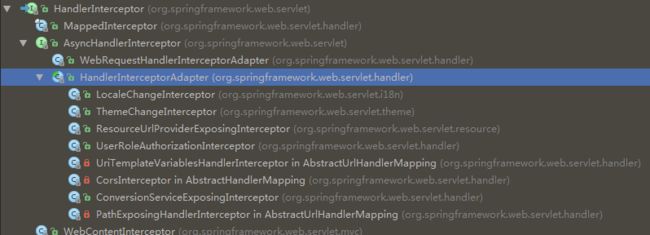SpringMVC拦截器源码解析
前言:提到拦截器,我们一定会想到Spring Aop。在看SpringMVC源码以前,一直以为SpringMVC的拦截器是用Spring Aop的动态代理来实现,并且也很困惑,如果用动态代理如何实现拦截器?这里就不介绍Spring Aop实现拦截器的方式,剖析SpringMVC 拦截器实现的细节。
SpringMVC拦截器也是Aop(面向切面)思想构建,但不是SpringAop动态代理实现的,主要采用责任链和适配器的设计模式来实现,直接嵌入到SpringMVC入口代码里面。
涉及到设计模式,有利于对代码的理解
责任链模式:https://segmentfault.com/a/1190000012079496
适配器模式:https://www.cnblogs.com/V1haoge/p/6479118.html
一、拦截器的接口类结构
拦截器的顶级接口为HandleInterceptor,提供三个接口,分别是preHandle(请求前)、postHandle(请求提交)、afterCompletion(请求完成后拦截)
package org.springframework.web.servlet;
import javax.servlet.http.HttpServletRequest;
import javax.servlet.http.HttpServletResponse;
import org.springframework.web.method.HandlerMethod;
/**
* 拦截器顶级接口
*/
public interface HandlerInterceptor {
//请求前拦截
boolean preHandle(HttpServletRequest request, HttpServletResponse response, Object handler)
throws Exception;
//提交请求拦截
void postHandle(
HttpServletRequest request, HttpServletResponse response, Object handler, ModelAndView modelAndView)
throws Exception;
//请求完成后拦截
void afterCompletion(
HttpServletRequest request, HttpServletResponse response, Object handler, Exception ex)
throws Exception;
}
而我们通常使用的是HandlerInterceptorAdapter(拦截器适配器),运用接口适配器模式。在实际运用中,接口中可以定义了很多方法,子类可能实现几个方法,接口适配器模式就起到了作用。
package org.springframework.web.servlet.handler;
import javax.servlet.http.HttpServletRequest;
import javax.servlet.http.HttpServletResponse;
import org.springframework.web.servlet.AsyncHandlerInterceptor;
import org.springframework.web.servlet.ModelAndView;
public abstract class HandlerInterceptorAdapter implements AsyncHandlerInterceptor {
@Override
public boolean preHandle(HttpServletRequest request, HttpServletResponse response, Object handler)
throws Exception {
return true;
}
@Override
public void postHandle(
HttpServletRequest request, HttpServletResponse response, Object handler, ModelAndView modelAndView)
throws Exception {
}
@Override
public void afterCompletion(
HttpServletRequest request, HttpServletResponse response, Object handler, Exception ex)
throws Exception {
}
/**
* This implementation is empty.
* 来自实现AsyncHandlerInterceptor 的方法
*/
@Override
public void afterConcurrentHandlingStarted(
HttpServletRequest request, HttpServletResponse response, Object handler)
throws Exception {
}
}二、拦截器源码运行的调用流程
1. HandlerMapping初始化
了解到SpringMVC拦截器接口HandlerInterceptorAdapter,我们再进入SpringMVC请求入口org.springframework.web.servlet.DispatcherServlet,拦截器运作工作流程由此展开。DispatcherServlet作为控制中心,拦截器就嵌入在入口方法中doDispatch中。SpringMVC又是如何将定义的拦截器加入进去呢?
/**
* 完成Servlet一系列初始化工作,包括视图解析器、处理器映射器、处理器适配器、主题解析器...
*/
protected void initStrategies(ApplicationContext context) {
initMultipartResolver(context);
initLocaleResolver(context);
initThemeResolver(context);
// 初始化RequestMapping,拦截器是作用在RequestMapping
initHandlerMappings(context);
initHandlerAdapters(context);
initHandlerExceptionResolvers(context);
initRequestToViewNameTranslator(context);
initViewResolvers(context);
initFlashMapManager(context);
}
初始化RequestMapping的时候,获取到RequestMapping的集合,因为拦截器作用在单个RequestMapping,来实现拦截器链。这里就不详细介绍RequestMapping的获取。
2. DispatcherServlet执行调用,doService作为Servlet主要执行者,通过调用doDispatch来真正执行请求处理
在initStrategies(ApplicationContext context)完成初始化准备工作后,来正式进入DispatcherServlet请求进入的处理过程。DispatcherServlet基于Servlet开发,它的执行方式是 doService(HttpServletRequest request, HttpServletResponse response)
/**
* doService做了一部分请求准备预处理的工作, 而实际处理的工作调用doDispatch(request, response)
*/
@Override
protected void doService(HttpServletRequest request, HttpServletResponse response) throws Exception {
if (logger.isDebugEnabled()) {
String resumed = WebAsyncUtils.getAsyncManager(request).hasConcurrentResult() ? " resumed" : "";
logger.debug("DispatcherServlet with name '" + getServletName() + "'" + resumed +
" processing " + request.getMethod() + " request for [" + getRequestUri(request) + "]");
}
// 对请求属性快照的保持和存储后的使用,
Map attributesSnapshot = null;
if (WebUtils.isIncludeRequest(request)) {
attributesSnapshot = new HashMap();
Enumeration attrNames = request.getAttributeNames();
while (attrNames.hasMoreElements()) {
String attrName = (String) attrNames.nextElement();
if (this.cleanupAfterInclude || attrName.startsWith(DEFAULT_STRATEGIES_PREFIX)) {
attributesSnapshot.put(attrName, request.getAttribute(attrName));
}
}
}
//对SpringMVC框架中处理器Handle和视图渲染,提前做准备工作
request.setAttribute(WEB_APPLICATION_CONTEXT_ATTRIBUTE, getWebApplicationContext());
request.setAttribute(LOCALE_RESOLVER_ATTRIBUTE, this.localeResolver);
request.setAttribute(THEME_RESOLVER_ATTRIBUTE, this.themeResolver);
request.setAttribute(THEME_SOURCE_ATTRIBUTE, getThemeSource());
// FlashMap是对重定向的参数传递的处理
FlashMap inputFlashMap = this.flashMapManager.retrieveAndUpdate(request, response);
if (inputFlashMap != null) {
request.setAttribute(INPUT_FLASH_MAP_ATTRIBUTE, Collections.unmodifiableMap(inputFlashMap));
}
request.setAttribute(OUTPUT_FLASH_MAP_ATTRIBUTE, new FlashMap());
request.setAttribute(FLASH_MAP_MANAGER_ATTRIBUTE, this.flashMapManager);
try {
//***请求的实际处理逻辑***-----进入方法
doDispatch(request, response);
}
finally {
if (!WebAsyncUtils.getAsyncManager(request).isConcurrentHandlingStarted()) {
// Restore the original attribute snapshot, in case of an include.
if (attributesSnapshot != null) {
restoreAttributesAfterInclude(request, attributesSnapshot);
}
}
}
} 3. doDispatch中完成拦截器的添加和拦截器拦截处理
doService做了一部分请求准备预处理的工作,包括请求中设置处理器和视图的属性,作用于后续处理器的运作和视图渲染, 而实际请求逻辑处理的工作调用doDispatch(request, response),也是我们需要重点跟进的代码。或许大家初次看doDispatch方法中的代码,还不知道拦截器在哪里运作。
处理流程是:
- 通过getHandler(HttpServletRequest request)获取到HandlerExecutionChain处理器执行链,将拦截器注入到HandlerExecutionChain属性
- 分别调用HandlerExecutionChain的三个方法,applyPreHandle、applyPostHandle、triggerAfterCompletion,实现前置拦截/请求提交拦截和请求完成后拦截。使用责任链的设计模式,实际调用的是HandleInterceptor的三个接口,分别对应preHandle、postHandle、afterCompletion
protected void doDispatch(HttpServletRequest request, HttpServletResponse response) throws Exception {
HttpServletRequest processedRequest = request;
HandlerExecutionChain mappedHandler = null;
boolean multipartRequestParsed = false;
WebAsyncManager asyncManager = WebAsyncUtils.getAsyncManager(request);
try {
ModelAndView mv = null;
Exception dispatchException = null;
try {
processedRequest = checkMultipart(request);
multipartRequestParsed = (processedRequest != request);
//***获取到请求执行链,拦截器的添加在里面完成***---进入方法
mappedHandler = getHandler(processedRequest);
if (mappedHandler == null || mappedHandler.getHandler() == null) {
noHandlerFound(processedRequest, response);
return;
}
// 获取到相应处理器适配器
HandlerAdapter ha = getHandlerAdapter(mappedHandler.getHandler());
// Process last-modified header, if supported by the handler.
String method = request.getMethod();
boolean isGet = "GET".equals(method);
if (isGet || "HEAD".equals(method)) {
long lastModified = ha.getLastModified(request, mappedHandler.getHandler());
if (logger.isDebugEnabled()) {
logger.debug("Last-Modified value for [" + getRequestUri(request) + "] is: " + lastModified);
}
if (new ServletWebRequest(request, response).checkNotModified(lastModified) && isGet) {
return;
}
}
//1.请求前拦截处理---进入方法细看(责任链模式,调用拦截器链的执行)
if (!mappedHandler.applyPreHandle(processedRequest, response)) {
return;
}
// Actually invoke the handler.
mv = ha.handle(processedRequest, response, mappedHandler.getHandler());
if (asyncManager.isConcurrentHandlingStarted()) {
return;
}
applyDefaultViewName(processedRequest, mv);
//2.请求提交的拦截处理---进入方法细看(责任链模式,调用拦截器链的执行)
mappedHandler.applyPostHandle(processedRequest, response, mv);
}
catch (Exception ex) {
dispatchException = ex;
}
catch (Throwable err) {
// As of 4.3, we're processing Errors thrown from handler methods as well,
// making them available for @ExceptionHandler methods and other scenarios.
dispatchException = new NestedServletException("Handler dispatch failed", err);
}
// 3.请求结果视图渲染完成后,调用mappedHandler.triggerAfterCompletion(),实现请求完成后拦截
processDispatchResult(processedRequest, response, mappedHandler, mv, dispatchException);
}
catch (Exception ex) {
triggerAfterCompletion(processedRequest, response, mappedHandler, ex);
}
catch (Throwable err) {
triggerAfterCompletion(processedRequest, response, mappedHandler,
new NestedServletException("Handler processing failed", err));
}
finally {
if (asyncManager.isConcurrentHandlingStarted()) {
// Instead of postHandle and afterCompletion
if (mappedHandler != null) {
mappedHandler.applyAfterConcurrentHandlingStarted(processedRequest, response);
}
}
else {
// Clean up any resources used by a multipart request.
if (multipartRequestParsed) {
cleanupMultipart(processedRequest);
}
}
}
}
三、结合责任链设计在拦截器中的运用
责任链模式的定义:使多个对象都有机会处理请求,从而避免请求的发送者和接受者之间的耦合关系, 将这个对象连成一条链,并沿着这条链传递该请求,直到有一个对象处理他为止。
分析 1、如何将拦截器添加到HandlerExecutionChain中
首先遍历HandlerMappings集合,HandlerMappings是在initHandlerMappings(context)初始化得到。根据request查找到相应 HandlerMapping的HandlerExecutionChain。
protected HandlerExecutionChain getHandler(HttpServletRequest request) throws Exception {
//遍历处理器映射器集合,找到相应请求的处理器映射器
for (HandlerMapping hm : this.handlerMappings) {
if (logger.isTraceEnabled()) {
logger.trace(
"Testing handler map [" + hm + "] in DispatcherServlet with name '" + getServletName() + "'");
}
//***请求匹配到映射器,并返回HandlerExecutionChain***---进入方法细看
//----拦截器的添加在方法里面完成
HandlerExecutionChain handler = hm.getHandler(request);
if (handler != null) {
return handler;
}
}
return null;
}@Override
public final HandlerExecutionChain getHandler(HttpServletRequest request) throws Exception {
Object handler = getHandlerInternal(request);
if (handler == null) {
handler = getDefaultHandler();
}
if (handler == null) {
return null;
}
// Bean name or resolved handler?
if (handler instanceof String) {
String handlerName = (String) handler;
handler = getApplicationContext().getBean(handlerName);
}
//***获取HandlerExecutionChain,拦截器的添加 ***---进一步跟进代码
HandlerExecutionChain executionChain = getHandlerExecutionChain(handler, request);
if (CorsUtils.isCorsRequest(request)) {
CorsConfiguration globalConfig = this.globalCorsConfigSource.getCorsConfiguration(request);
CorsConfiguration handlerConfig = getCorsConfiguration(handler, request);
CorsConfiguration config = (globalConfig != null ? globalConfig.combine(handlerConfig) : handlerConfig);
executionChain = getCorsHandlerExecutionChain(request, executionChain, config);
}
return executionChain;
}/**
* 走到这里,才真正看到了HandlerExecutionChain的创建和拦截器的添加
*/
protected HandlerExecutionChain getHandlerExecutionChain(Object handler, HttpServletRequest request) {
//获取到HandlerExecutionChain
HandlerExecutionChain chain = (handler instanceof HandlerExecutionChain ?
(HandlerExecutionChain) handler : new HandlerExecutionChain(handler));
String lookupPath = this.urlPathHelper.getLookupPathForRequest(request);
//遍历拦截器,adaptedInterceptors也是在initHandlerMapping初始化得到
for (HandlerInterceptor interceptor : this.adaptedInterceptors) {
if (interceptor instanceof MappedInterceptor) {
MappedInterceptor mappedInterceptor = (MappedInterceptor) interceptor;
if (mappedInterceptor.matches(lookupPath, this.pathMatcher)) {
//将拦截器添加
chain.addInterceptor(mappedInterceptor.getInterceptor());
}
}
else {
chain.addInterceptor(interceptor);
}
}
return chain;
}分析2、如何执行多个拦截器,通过责任链模式
boolean applyPreHandle(HttpServletRequest request, HttpServletResponse response) throws Exception {
HandlerInterceptor[] interceptors = getInterceptors();
if (!ObjectUtils.isEmpty(interceptors)) {
for (int i = 0; i < interceptors.length; i++) {
HandlerInterceptor interceptor = interceptors[i];
if (!interceptor.preHandle(request, response, this.handler)) {
triggerAfterCompletion(request, response, null);
return false;
}
this.interceptorIndex = i;
}
}
return true;
}
/**
* Apply postHandle methods of registered interceptors.
*/
void applyPostHandle(HttpServletRequest request, HttpServletResponse response, ModelAndView mv) throws Exception {
HandlerInterceptor[] interceptors = getInterceptors();
if (!ObjectUtils.isEmpty(interceptors)) {
for (int i = interceptors.length - 1; i >= 0; i--) {
HandlerInterceptor interceptor = interceptors[i];
interceptor.postHandle(request, response, this.handler, mv);
}
}
}/**
* Trigger afterCompletion callbacks on the mapped HandlerInterceptors.
* Will just invoke afterCompletion for all interceptors whose preHandle invocation
* has successfully completed and returned true.
*/
void triggerAfterCompletion(HttpServletRequest request, HttpServletResponse response, Exception ex)
throws Exception {
HandlerInterceptor[] interceptors = getInterceptors();
if (!ObjectUtils.isEmpty(interceptors)) {
for (int i = this.interceptorIndex; i >= 0; i--) {
HandlerInterceptor interceptor = interceptors[i];
try {
interceptor.afterCompletion(request, response, this.handler, ex);
}
catch (Throwable ex2) {
logger.error("HandlerInterceptor.afterCompletion threw exception", ex2);
}
}
}
}